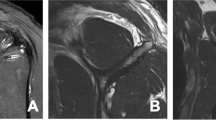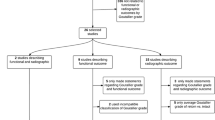Abstract
Purpose
Fatty infiltration (FI) is known to be an irreversible change which continues degeneration after rotator cuff repair. Previous studies evaluated postoperative changes in FI using a preoperative baseline. This study aimed to investigate the changes in FI using an immediate postoperative baseline. We hypothesized that FI was progressed more when measured relative to an immediate postoperative baseline than to a preoperative baseline.
Methods
From 2008 to 2010, 77 patients who met the following criteria were included in this study: arthroscopic rotator cuff repair of a full-thickness rotator cuff tear and presence of preoperative (approximately 1 month before surgery), immediate postoperative (approximately 3 days after surgery), and 1-year postoperative (at least 9 months to 1 year after surgery) magnetic resonance imaging (MRI) undertaken. The exclusion criteria were: absence of any of the three MRIs, isolated subscapularis repair, and rotator cuff repair with margin convergence only. The MRIs were examined to assess the Goutallier grade of the rotator cuff muscles for the assessment of FI. Structural integrity was evaluated using the Sugaya classification. Measurements 1 year after surgery were compared with those at the preoperative and immediate postoperative time points according to the integrity.
Results
In the total and retear group, FI in the supraspinatus and infraspinatus 1 year after surgery did not change significantly relative to the preoperative baseline (all n.s.), but progressed compared to the immediate postoperative baseline (all p < 0.001). In the retear group, FI in the supraspinatus and infraspinatus reduced for seven and two of 20 patients, respectively, compared with the preoperative baseline; however, no patients showed a reduced FI compared with the immediate postoperative baseline.
Conclusions
The results of the study showed that the changes in FI reduced, remained or progressed in accordance with the baseline and structural integrity. FI progressed when compared with the immediate postoperative baseline than with the preoperative baseline. The immediate postoperative time point would be considered as the baseline to monitor the true changes of FI after repair.
Level of evidence
Retrospective comparative study, Level III.





Similar content being viewed by others
References
Adamson GJ, Tibone JE (1993) Ten-year assessment of primary rotator cuff repairs. J Shoulder Elbow Surg 2:57–63
Anderson KM, Jaruga P, Ramsey CR, Gilman NK, Green VM, Rostad SW, Emerman JT, Dizdaroglu M, Malins DC (2006) Structural alterations in breast stromal and epithelial DNA: the influence of 8,5′-cyclo-2′-deoxyadenosine. Cell Cycle 5:1240–1244
Boileau P, Brassart N, Watkinson DJ, Carles M, Hatzidakis AM, Krishnan SG (2005) Arthroscopic repair of full-thickness tears of the supraspinatus: does the tendon really heal? J Bone Joint Surg Am 87:1229–1240
Cofield RH, Parvizi J, Hoffmeyer PJ, Lanzer WL, Ilstrup DM, Rowland CM (2001) Surgical repair of chronic rotator cuff tears. A prospective long-term study. J Bone Joint Surg Am 83-A:71–77
Coleman SH, Fealy S, Ehteshami JR, MacGillivray JD, Altchek DW, Warren RF, Turner AS (2003) Chronic rotator cuff injury and repair model in sheep. J Bone Joint Surg Am 85-A:2391–2402
Cuff DJ, Pupello DR (2012) Prospective randomized study of arthroscopic rotator cuff repair using an early versus delayed postoperative physical therapy protocol. J Shoulder Elbow Surg 21:1450–1455
Deniz G, Kose O, Tugay A, Guler F, Turan A (2014) Fatty degeneration and atrophy of the rotator cuff muscles after arthroscopic repair: does it improve, halt or deteriorate? Arch Orthop Trauma Surg 134:985–990
Fuchs B, Gilbart MK, Hodler J, Gerber C (2006) Clinical and structural results of open repair of an isolated one-tendon tear of the rotator cuff. J Bone Joint Surg Am 88:309–316
Fuchs B, Weishaupt D, Zanetti M, Hodler J, Gerber C (1999) Fatty degeneration of the muscles of the rotator cuff: assessment by computed tomography versus magnetic resonance imaging. J Shoulder Elbow Surg 8:599–605
Galatz LM, Ball CM, Teefey SA, Middleton WD, Yamaguchi K (2004) The outcome and repair integrity of completely arthroscopically repaired large and massive rotator cuff tears. J Bone Joint Surg Am 86-A:219–224
Gerber C, Fuchs B, Hodler J (2000) The results of repair of massive tears of the rotator cuff. J Bone Joint Surg Am 82:505–515
Gerber C, Meyer DC, Schneeberger AG, Hoppeler H, von Rechenberg B (2004) Effect of tendon release and delayed repair on the structure of the muscles of the rotator cuff: an experimental study in sheep. J Bone Joint Surg Am 86-A:1973–1982
Gladstone JN, Bishop JY, Lo IK, Flatow EL (2007) Fatty infiltration and atrophy of the rotator cuff do not improve after rotator cuff repair and correlate with poor functional outcome. Am J Sports Med 35:719–728
Goutallier D, Postel JM, Bernageau J, Lavau L, Voisin MC (1994) Fatty muscle degeneration in cuff ruptures. Pre- and postoperative evaluation by CT scan. Clin Orthop Relat Res 304:78–83
Goutallier D, Postel JM, Gleyze P, Leguilloux P, Van Driessche S (2003) Influence of cuff muscle fatty degeneration on anatomic and functional outcomes after simple suture of full-thickness tears. J Shoulder Elbow Surg 12:550–554
Jo CH, Kim JE, Yoon KS, Lee JH, Kang SB, Lee JH, Han HS, Rhee SH, Shin S (2011) Does platelet-rich plasma accelerate recovery after rotator cuff repair? A prospective cohort study. Am J Sports Med 39:2082–2090
Jo CH, Park JW, Shin JS (2016) Changes of muscle atrophy according to the immediate postoperative time point in magnetic resonance Imaging after arthroscopic rotator cuff repair. Arthroscopy 32:2477–2487
Jo CH, Shin JS (2013) Changes in appearance of fatty infiltration and muscle atrophy of rotator cuff muscles on magnetic resonance imaging after rotator cuff repair: establishing new time-zero traits. Arthroscopy 29:449–458
Jo CH, Shin JS (2013) Cross-sectional area of the supraspinatus muscle after rotator cuff repair: an anatomic measure of outcome. J Bone Joint Surg Am 95:1785–1791
Jo CH, Shin JS, Lee YG, Shin WH, Kim H, Lee SY, Yoon KS, Shin S (2013) Platelet-rich plasma for arthroscopic repair of large to massive rotator cuff tears: a randomized, single-blind, parallel-group trial. Am J Sports Med 41:2240–2248
Jo CH, Yoon KS, Lee JH, Kang SB, Lee JH, Han HS, Rhee SH, Shin JS (2011) The effect of multiple channeling on the structural integrity of repaired rotator cuff. Knee Surg Sports Traumatol Arthrosc 19:2098–2107
Jost B, Zumstein M, Pfirrmann CW, Gerber C (2006) Long-term outcome after structural failure of rotator cuff repairs. J Bone Joint Surg Am 88:472–479
Juul-Kristensen B, Bojsen-Moller F, Finsen L, Eriksson J, Johansson G, Stahlberg F, Ekdahl C (2000) Muscle sizes and moment arms of rotator cuff muscles determined by magnetic resonance imaging. Cells Tissues Organs 167:214–222
Kovacevic D, Rodeo SA (2008) Biological augmentation of rotator cuff tendon repair. Clin Orthop Relat Res 466:622–633
Lee BG, Cho NS, Rhee YG (2012) Effect of two rehabilitation protocols on range of motion and healing rates after arthroscopic rotator cuff repair: aggressive versus limited early passive exercises. Arthroscopy 28:34–42
Liem D, Lichtenberg S, Magosch P, Habermeyer P (2007) Magnetic resonance imaging of arthroscopic supraspinatus tendon repair. J Bone Joint Surg Am 89:1770–1776
Matsumoto F, Uhthoff HK, Trudel G, Loehr JF (2002) Delayed tendon reattachment does not reverse atrophy and fat accumulation of the supraspinatus—an experimental study in rabbits. J Orthop Res 20:357–363
Melis B, Nemoz C, Walch G (2009) Muscle fatty infiltration in rotator cuff tears: descriptive analysis of 1688 cases. Orthop Traumatol Surg Res 95:319–324
Nakagaki K, Ozaki J, Tomita Y, Tamai S (1994) Alterations in the supraspinatus muscle belly with rotator cuff tearing: evaluation with magnetic resonance imaging. J Shoulder Elbow Surg 3:88–93
Oh JH, Kim SH, Ji HM, Jo KH, Bin SW, Gong HS (2009) Prognostic factors affecting anatomic outcome of rotator cuff repair and correlation with functional outcome. Arthroscopy 25:30–39
Sugaya H, Maeda K, Matsuki K, Moriishi J (2005) Functional and structural outcome after arthroscopic full-thickness rotator cuff repair: single-row versus dual-row fixation. Arthroscopy 21:1307–1316
Thomazeau H, Boukobza E, Morcet N, Chaperon J, Langlais F (1997) Prediction of rotator cuff repair results by magnetic resonance imaging. Clin Orthop Relat Res 344:275–283
Yamaguchi H, Suenaga N, Oizumi N, Hosokawa Y, Kanaya F (2012) Will preoperative atrophy and Fatty degeneration of the shoulder muscles improve after rotator cuff repair in patients with massive rotator cuff tears? Adv Orthop 2012:195876
Zanetti M, Gerber C, Hodler J (1998) Quantitative assessment of the muscles of the rotator cuff with magnetic resonance imaging. Invest Radiol 33:163–170
Author information
Authors and Affiliations
Corresponding author
Ethics declarations
Conflict of interest
All authors have no conflict of interest to disclose.
Funding
This work was supported by the Bio and Medical Technology Development Program of the NRF funded by the Korean government, MSIP (2011-0019773 and 2015M3A9E6028412).
Ethical approval
All procedures performed in studies involving human participants were in accordance with the ethical standards of SMG-SNU Boramae Medical Center and with the 1964 Helsinki declaration and its later amendments or comparable ethical standards.
Informed consent
Informed consent was obtained from all participants included in the study.
Rights and permissions
About this article
Cite this article
Park, J.W., Jo, C.H. & Shin, J.S. Changes of fatty infiltration according to the immediate postoperative time point in magnetic resonance imaging after arthroscopic rotator cuff repair. Knee Surg Sports Traumatol Arthrosc 26, 152–160 (2018). https://doi.org/10.1007/s00167-017-4604-9
Received:
Accepted:
Published:
Issue Date:
DOI: https://doi.org/10.1007/s00167-017-4604-9




